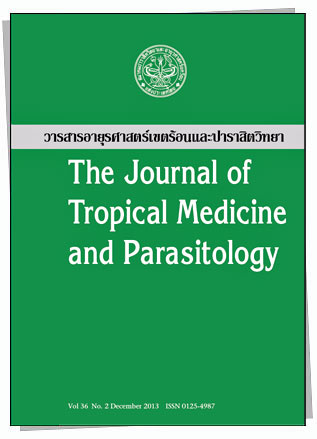Prevalence of Gastrointestinal Parasitic Infections in Refuge Dogs and Cats and Evaluation of Two Conventional Examination Techniques
Main Article Content
Abstract
The purposes of the study were to determine the prevalence of gastrointestinal protozoan and helminthic infections among “refuge” dogs and cats in Pathum Thani and Nakhon Pathom provinces, using direct/simple smear (SS) and formalin-ether concentration techniques (FECT), and to evaluate the recovery efficiency and reliability of SS compared with FECT. Fifty samples each from dogs and cats in Pathum Thani Province, and 100 samples each from dogs and cats in Nakhon Pathom Province, were collected. All fecal samples were subjected to the two techniques, processed in duplicate, and examined for gastrointestinal parasites. In Pathum Thani refuge, the overall prevalence rates among the dogs by SS were 8.0% and 4.0%, and by FECT 10.0% and 8.0%; among the cats, the rates by SS were 34.0% and 34.0%, and by FECT 82.0% and 78.0%. In Nakhon Pathom refuge, the rates among the dogs by SS were 7.0% and 6.0%, and by FECT 28.0% and 20.0%; among the cats by SS the rates were 24.0% and 22.0%, and by FECT 48.0% and 46.0%. Toxocara cati was the most prevalent helminth among cats in Pathum Thani refuge, whereas hookworm infections were highest in both dogs and cats in Nakhon Pathom refuge. The infection intensity among all dogs and cats in both refuges was considered light. All positive fecal samples detected by SS were also detected by FECT. The recovery rate for SS was 25.0% (7/28) to 80.0% (4/5), compared with FECT. In the Pathum Thani observation, the reliability of SS for detecting parasitic infections in dogs and cats was statistically poor (ê = -0.5 and 0.38), while the reliability of FECT for dogs was excellent (ê = 0.88) and cats fair to good (ê = 0.50). The agreement between SS and FECT for overall parasitic infections was poor (ê = 0.31 and 0.20). In the Nakhon Pathom observation, the reliability of SS for detecting parasitic infections among dogs and cats was excellent (ê = 0.92 and 0.94); FECT was also excellent (ê = 0.62 and 0.84). The agreement between SS and FECT for overall parasitic infections among dogs was poor (ê = 0.32), whereas among cats it was fair to good (ê = 0.51). The results indicate that if the sample size of the animals is large enough (n = 100) and the prevalence of parasitic infections is not too low (≥ 24%), SS was statistically reliable and was fair-to-good in agreeing with FECT, although the recovery rate was about 50% lower.

